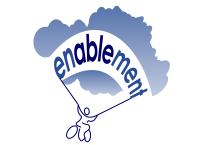Multidisciplinary and Interdisciplinary Management in Cerebral Palsy
Top Contributors - Roelie Wolting, Kim Jackson, Leana Louw, Michelle Lee, Laura Ritchie, Shaimaa Eldib, Rucha Gadgil, Rania Nasr, Jess Bell, Admin, Naomi O'Reilly, Simisola Ajeyalemi, Amrita Patro, Evan Thomas and Vidya Acharya
Introduction [edit | edit source]
The information on this page has developed for you from the expert work of Roelie Wolting alongside the Enablement Cerebral Palsy Project and Handicap International Group.
Facilitating Factors[edit | edit source]
Facilitating factors are factors which stimulate, provide, or promote, a positive environment for children with disability.
The main factor which facilitated inclusion in the previous animation is the change of attitude among adults/professionals and children.
- Stakeholders: teachers, parents, children, health professionals, community.
- Roles and responsibilities: awareness on rights and abilities of children with disabilities for professionals (and community members, including parents of schoolchildren); working as a team (should be joined action and responsibility); education of children in the school about disability; clear rules about (not)accepted behaviour; making environment barrier free.
- Your responsibility is not just to provide the assistive devices (as you see in the animation: this in itself does not facilitate inclusion) but also to give info about the disability, how to adapt the environment.
Multidisciplinary Discilinary Team (MDT)[edit | edit source]
Children with cerebral palsy present many medical problems that can be treated or prevented. Often, the initial stage of treatment can involve an interdisciplinary team, which can consist of a paediatrician, preferable one with experience in neurological developmental disorders, a neurologist (or other neurological practitioner), a mental health practitioner, an orthopaedic surgeon, a physical therapist, a speech therapist, and an occupational therapist. Each member of the team has important contributions to make in the care of the affected child. Here are some of the roles of the MDT
- The physical therapist evaluates muscle tone, strength, and gait (walking).�
- The occupational therapist reviews the child's ability to perform tasks of self-help and care -- from feeding to manual dexterity.�
- The speech therapist evaluates the child's ability to speak and understand speech.�
Each discipline then develops their own intervention plan.
The number of people involved may be less and in poor resourced places less disciplines may be involved.
Modles of Team Practice[edit | edit source]
In the multidisciplinary approach individuals each approach a situation or problem from their own perspective and then share findings.
Interdisciplinary teams are similarly interdependent, but efforts are collaborative and team members work together toward a resolution.
In transdisciplinary teams, disciplinary lines are more blurred.
Transdisciplinary Team
[edit | edit source]
A transdisciplinary team is one in which members come together from the beginning to jointly communicate, exchange ideas and work together to come up with solutions to problems. As the prefix "trans" indicates, transdisciplinarity concerns that which is at once between the disciplines, across the different disciplines, and beyond each individual discipline. Transdisciplinary service is defined as the sharing of roles across disciplinary boundaries so that communication, interaction, and cooperation are maximised among team members









